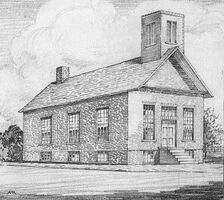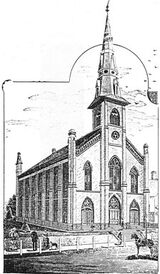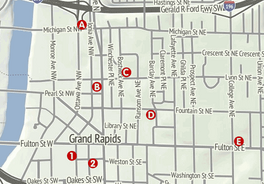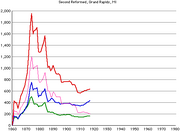
Second Reformed Church, 1849-1854
Second Reformed Church was created to meet the needs of Dutch immigrants. Supported by First Reformed, it organized in 1849. The congregations united with First Reformed to form Central Reformed in 1918.
History[]
Hiram H. Van Reede's family were the first Dutch immigrants to Grand Rapids, Michigan. When the arrived in 1847, they joined the First Reformed Church. They were not affiliated with the larger Dutch immigration that came to west Michigan later that year under the leadership of Albertus Van Raalte.
The first of that group to settle in Grand Rapids was Fancis Van Driele, who moved to Grand Rapids in 1848, and he was soon followed by others, who were also welcomed by First Reformed. By July or August of 1849, Van Raalte organized Second Reformed as part of the Dutch-speaking Holland Classis. With the rest of the Classis, it joined the Dutch Reformed Church (now Reformed Church in America) in 1850.
Grand Rapids incorporated as a city in 1850, with city limits of Leonard Street on the north, East Street (now Eastern Avenue) on the east, Wealthy Street on the south, and Straight Street on the west. The 1850 U.S. Census showed a population of 2,686 in Grand Rapids, of whom 189 were Dutch-born.
By 1854, Second Reformed was able to hire its own pastor, calling Rev. H. G. Klyn as its first minister.

Second Reformed Church, 1870-1895
Trouble came to the congregation in 1856, fomented by Gijsbert Haan, who led an exodus from Second in 1857 (including Rev. Klyn) over perceived laxity in theology and practice in the Dutch Reformed Church. The seceders objected to the distribution of the Puritan Richard Baxter's Call to the Unconverted because it promoted general atonement, the admission of non-Reformed individuals to the Lord's Table, and the introduction of hymns to worship services.
This group formed First Christian Reformed Church and gave birth to the Christian Reformed denomination. About half the congregation left, and what remained of Second was forced to sell its parsonage so it could pay its bills.
Eight months later Rev. Klyn returned to the Reformed Church.
In 1870, the congregation built new facilities with a 1,000 seat sanctuary. When that reached capacity, Second decided to launch two daughter churches, Third to the east and Fourth to the north, in 1876, but it was soon again filled to capacity. In 1886, Second launched Fifth Reformed to the southwest.
In 1882, the lodge issue came to a head. The smaller Christian Reformed Church did not allow its members to belong to "secret societies", and the Reformed Church allowed its members to do so. This went against the tradition in the Netherlands and widely impacted Dutch speaking Reformed congregations. Many left for the CRC, including the majority of some congregations, and from that point forward the bulk of Dutch Reformed immigrants joined Christian Reformed congregations. Second lost about 400 members.
Second merged with First in 1918 to form Central Reformed.
Historical Details[]
Locations[]

Downtown locations of First Reformed, Second Reformed, and First Christian Reformed churches.
From its beginnings in 1849 until 1870, Second Reformed shared facilities with First Reformed at the corner of Michigan and Ottawa NW (A in map). In 1870, Second built a 1,000 seat sanctuary on Bostwick NE near Lyon Street (C). This building burned in 1895, and new facilities were built on the same site, where it remained until it merged with First to form Central Reformed (E) in 1918.
First Christian Reformed is shown by (1) and (2) on this map.
Pastors[]
- H. G. Klyn, 1854-57, withdrew with many members to form First Christian Reformed Church
- W. A. Houbolt, 1859-60
- Cornelius Vander Meulen, 1860-73
- N. H. Dosker, 1873-83
- Egbert Winter, 1883-95
- D. J. De Bey, 1896-1900
- M. Kolyn, 1901-10
- Henry Hospers, 1910-18
Daughter Churches[]
Membership Overview[]
Second Reformed, the only Dutch-speakiing Reformed Church congregation in Grand Rapids until 1984, achieved its membership peak in that year and then launched Third Reformed to its east. In 1875, it launched Fourth Reformed to the north. In 1886, it spun off Fifth Reformed on the south, and six years later, Ninth Reformed to the west across the Grand River. From the late 1880s until about 1910, membership declined, and Second merged with First Reformed in 1918.
Due to incomplete reporting, nonprofessing and total membership figures 1860-78, 1885-86, 1901-02, and 1909 are estimated.

Membership data, Second Reformed Church, Grand Rapids, MI
Overall Membership Data[]
Green (lower) line shows membership in families; blue (middle), professing members; red (top), total members; and magenta (thin), non-professing members. Note: 1st and 2nd Reformed charts cover 1860-1980, not 1880-2000 as in other charts.

Membership ratios, Second Reformed Church, Grand Rapids, MI
Youth Ratio[]
Red line shows nonprofessing members as a percentage of total membership (inactive members exluded).

Five year growth rate, Second Reformed Church, Grand Rapids, MI
Five Year Growth Rate[]
Red line shows five year growth rate. A five year growth rate between 10% and -10% is considered stable; greater than 10% indicates a growing congregation; one below -10% indicates a church in decline. This makes no allowance for daughter churches.
Data source: Acts of Synod of the Reformed Church in America. Dates are year prior to publication date since data is gathered at the end of one year and published in the next.
Sources[]
- History of the City of Grand Rapids, Michigan , Albert Baxter, 1891. Especially the section on Second Reformed Church